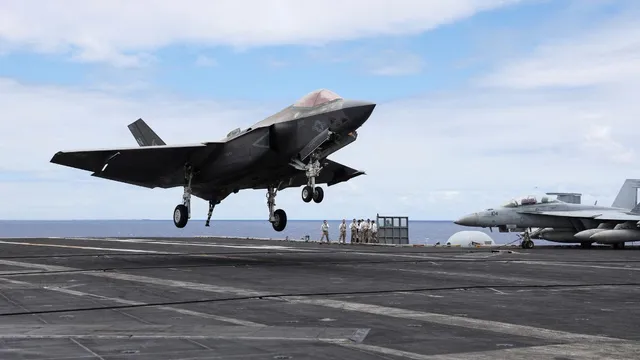- By Supratik Das
- Fri, 20 Jun 2025 10:40 AM (IST)
- Source:JND
In a significant strategic shift, the United States has pulled dozens of warplanes from the Al Udeid Airbase in Qatar, amid mounting fears of Iranian retaliation over the ongoing Israel-Iran conflict. Satellite images obtained by AFP on June 19 reveal that almost all planes that were earlier based there are no longer present, fueling speculation about Washington's next step. The move is made as United States President Donald Trump considers the possibility of a military strike against Iran, amid weeks of heightening attacks between Tehran and Tel Aviv.
Photos by Planet Labs PBC on June 5 revealed at least 40 military planes, including Hercules C-130 transport planes and surveillance aircraft, stored at the Al Udeid base. But new satellite imagery on June 19 revealed just three planes present. Though there has been no statement from the Pentagon on the move, but possibly as a precaution against a potential Iranian missile attack on US assets. Al Udeid, which is the largest US military base in the area, is "extremely vulnerable" because of its closeness to Iran, experts said to AFP. In a similar action, the US embassy in Qatar has announced restricted access to the Al Udeid Airbase “out of an abundance of caution and in light of ongoing regional hostilities.” Personnel have been advised to remain vigilant.
Satellite images of Al Udeid Air Base in Qatar, one of the U.S. Air Force’s most important bases in the Middle East, appear to show the base now completely abandoned. The base, which regularly maintains dozens of military aircraft, including aerial-refueling tankers, surveillance… pic.twitter.com/k102I9raP7
— OSINTdefender (@sentdefender) June 18, 2025
Trump To Decide On Iran Strike In Two Weeks
In a press briefing on Thursday, White House Press Secretary Karoline Leavitt stated President Trump would make a decision "within the next two weeks" about possible US involvement in the Israel-Iran conflict. “There’s a substantial chance of negotiations that may or may not take place with Iran in the near future. Based on that, I will make my decision whether or not to go,” Leavitt quoted Trump as saying. Trump, when asked earlier this week about the possibility of a strike, remained noncommittal: “I may do it, I may not do it. I mean, nobody knows what I’m going to do.” After his G7 visit, Trump also mentioned that US is planning something "much bigger than that" and posted this on Truth Social.
According to US officials, communication lines between Washington and Tehran remain open, though details of the negotiations remain undisclosed. According to Iran's state-run media, US special envoy Steve Witkoff has had multiple conversations with Iranian Foreign Minister Abbas Araghchi since June 13, when Israel launched direct strikes on Iranian targets.
As part of backchannel diplomacy, the US is said to have suggested that Iran join a regional uranium enrichment consortium beyond its borders, to check Tehran's nuclear ambitions. Iran has so far rejected the proposal and continued its attacks on Tel Aviv, although it has signaled possible flexibility if Israel ends its military campaign. Iranian authorities also cautioned that further escalation might lead to attacks on US military bases and commercial shipping routes, including in the Strait of Hormuz, a key chokepoint for global oil supplies. Gradually, with the threat of Iranian strikes on oil tankers in the Strait of Hormuz looming, global energy markets are bracing for potential disruptions. A full-blown conflict could lead to skyrocketing oil prices and major disruptions in maritime trade.

